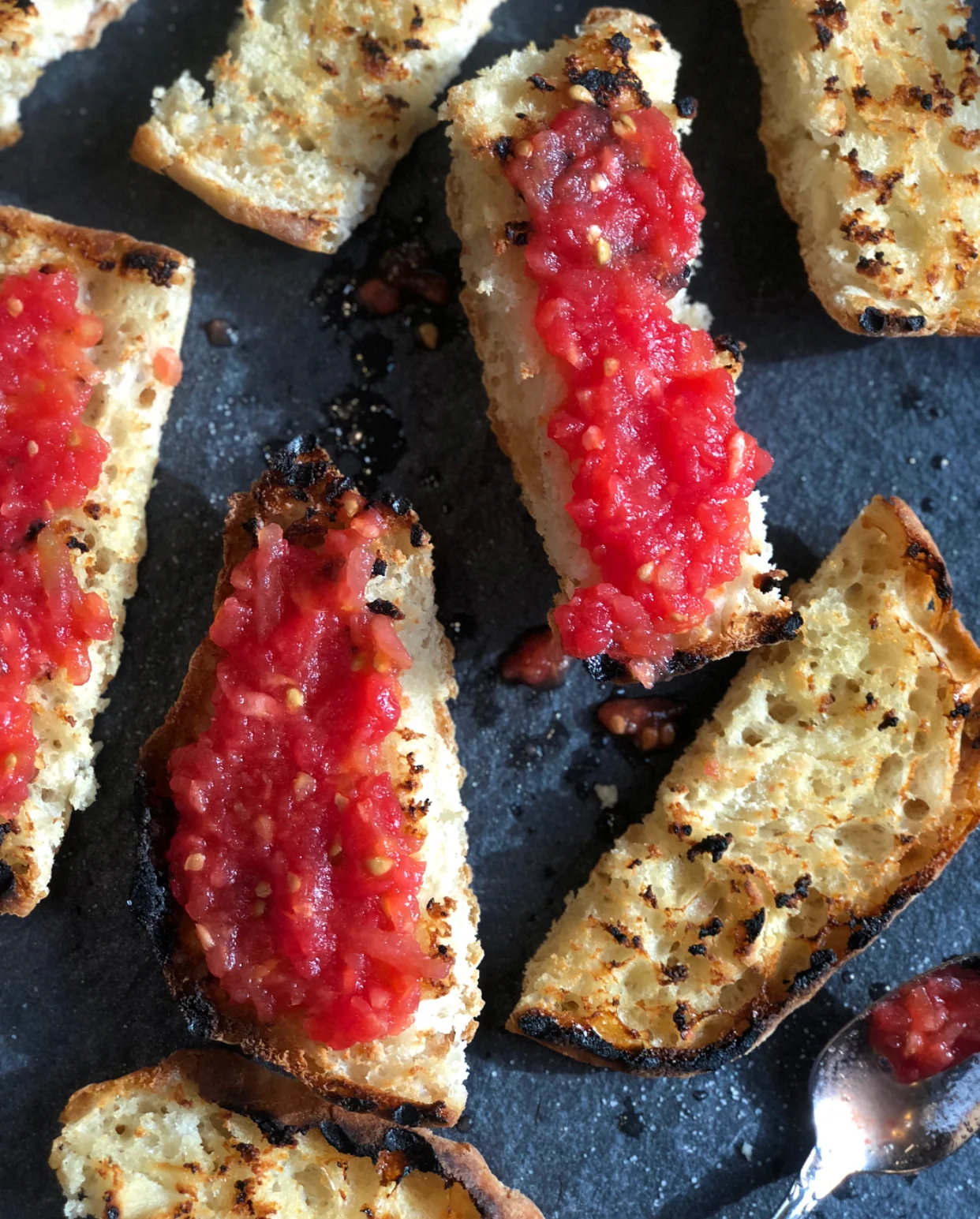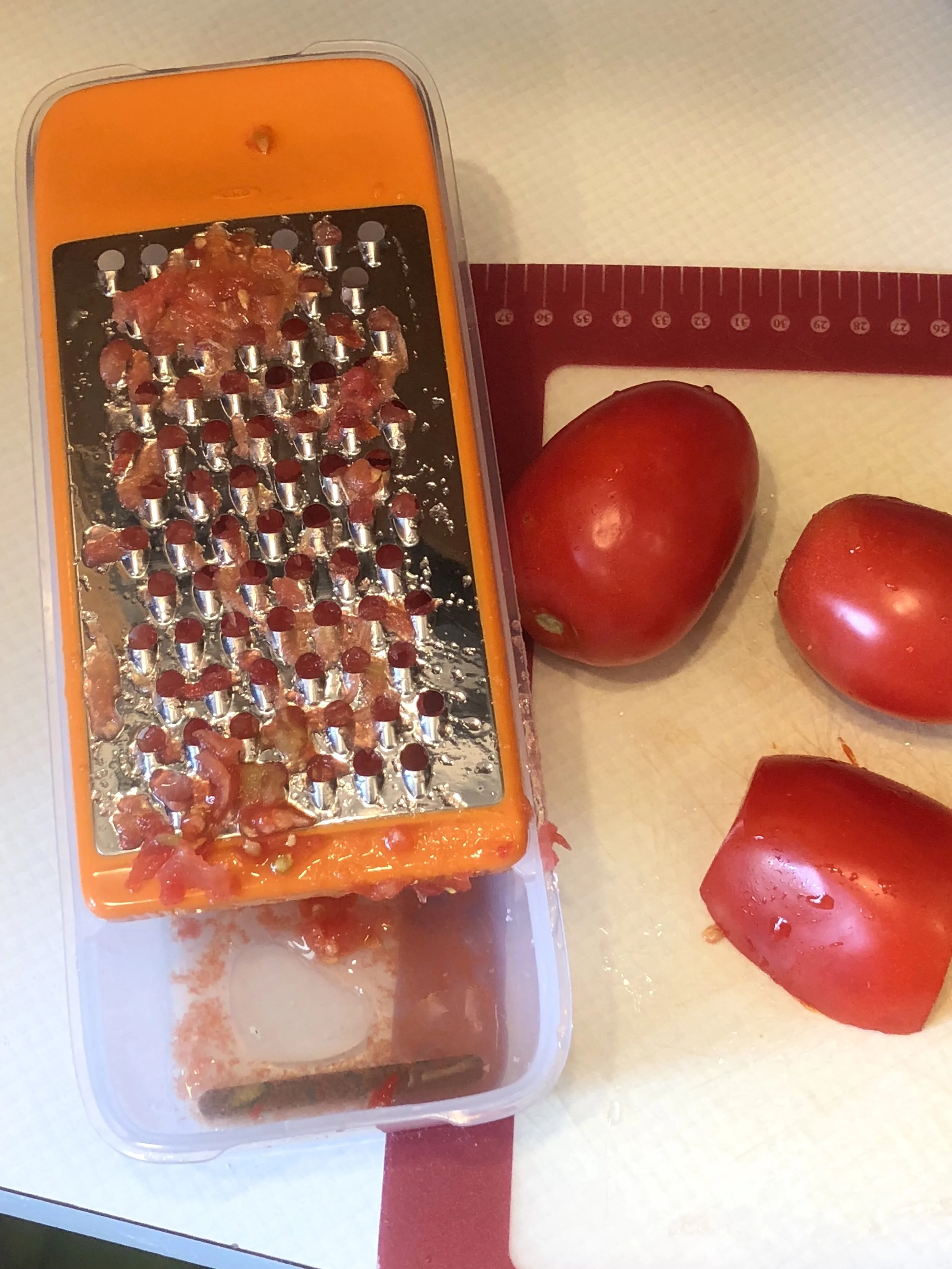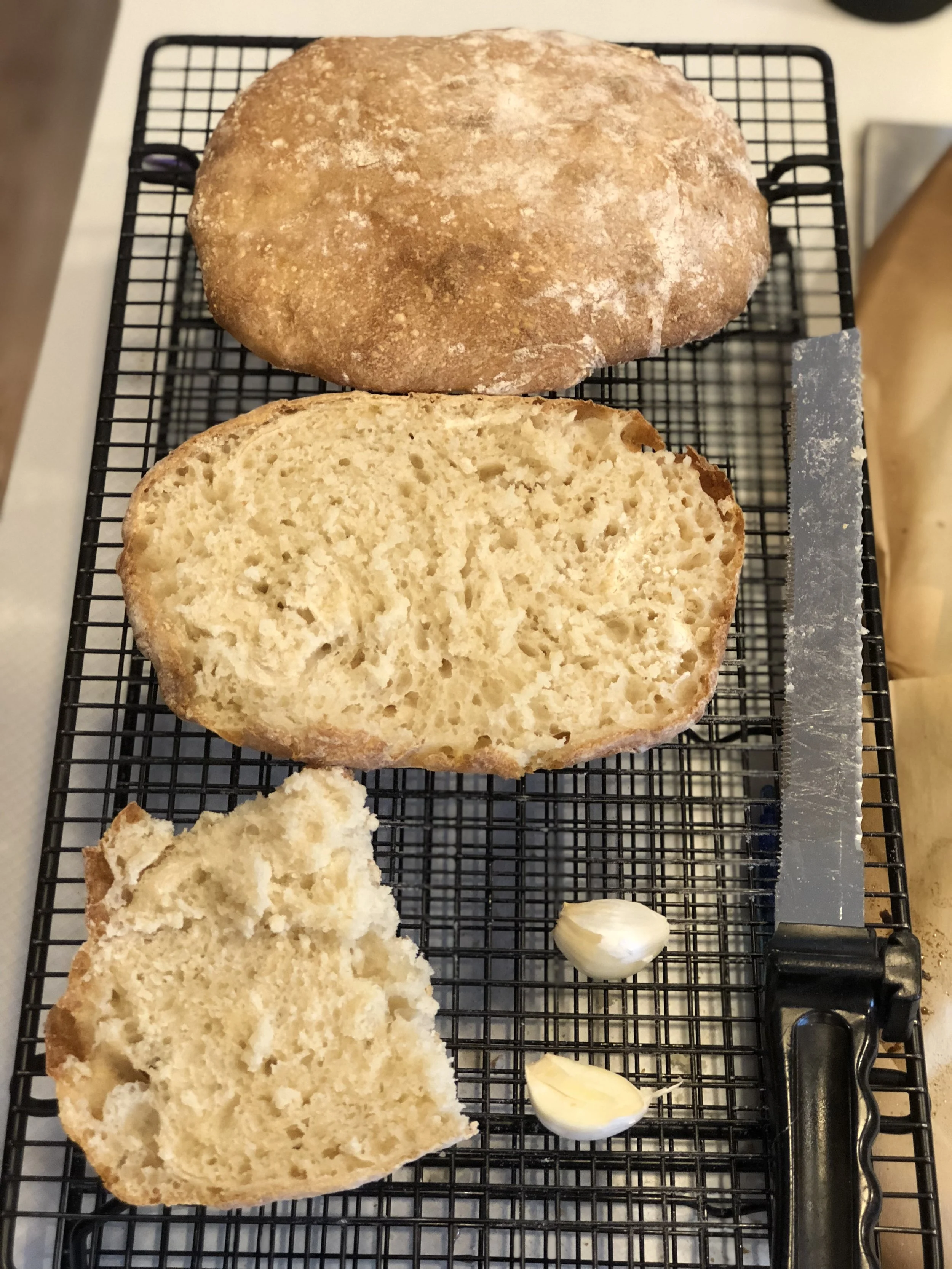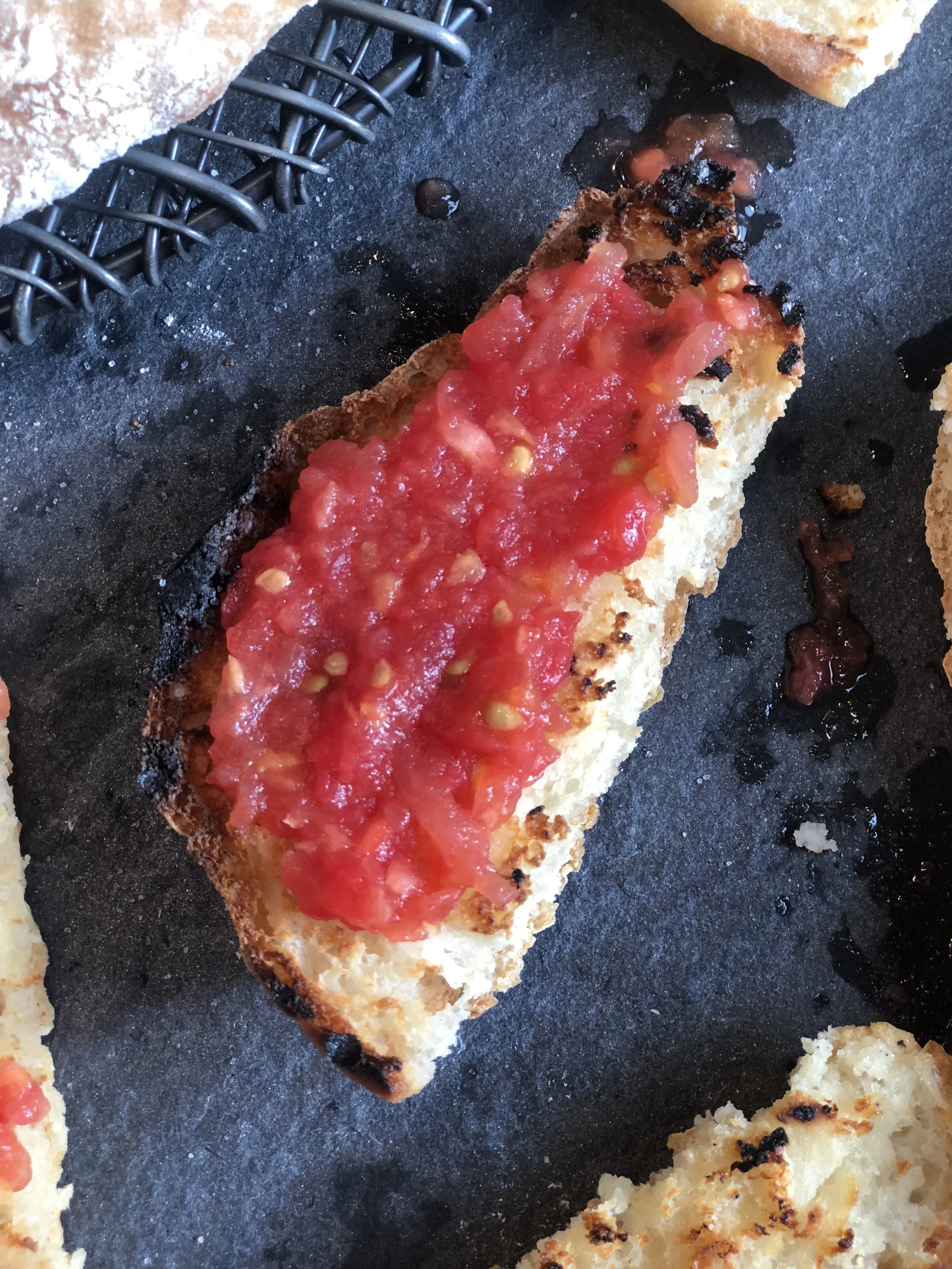Pan con Tomate
“Pan con Tomate” means bread with tomatoes and it's deliciously simple. Last winter I spent two weeks studying in Spain, where this combo of ciabatta, garlic, tomatoes and olive oil was one of my go-to breakfast buddies.
Yes, this tomato bread can be for breakfast. If you’re in the U.S. this is something you might consider an appetizer before dinner, but I want you to reconsider that. Nothing pairs better with this crusty tomato-y bread than some fresh fruit and creamy coffee.
Gratin' tomaters!
The ciabatta, ready to be infused with garlic!
Making your own ciabatta is a little nuts. I did it and the Bread Illustrated recipe I used is below, but there’s no shame in just buying a dang ciabatta loaf. Preferably, support a local bakery that cares about the environment.
If you choose to make the ciabatta, I’ll warn you now: this dough is supes sticky and kinda messy. You’re gonna have to liberally flour your counter. After you nail the ciabatta (if you’re up for the challenge), this recipe is smooth sailing.
Tell me all about your country’s breakfast traditions in the comments and don’t forget to follow the sustainability tips below!
Makes: two loaves, plus toppings
Serves: four to six people for a meal, eight to twelve for a snack
Time: 10 hours if you make the bread, 10 minutes if you don’t
Ingredients
for the topping
8-10 Plum tomatoes
3/4 teaspoon sea salt, or more to taste
Olive oil for brushing and drizzling
1 whole clove garlic
for the ciabatta (courtesy of Bread Illustrated)
sponge
1 cup all-purpose flour
½ cup water
1/8 teaspoon rapid rise yeast
dough
2 cups all-purpose flour
1 ½ teaspoons salt
½ teaspoon rapid rise yeast
¼ cup whole milk, room temperature
¾ cup water
Steps
toppings
(if you’re making your own ciabatta, do that first. recipe is below.)
Wash your tomatoes and slice them in half length-wise. Using a grater with large holes, rub the flesh side of the tomato on the grater. When you’re done, just the tomato’s skin should be left. Compost that! Grate all tomatoes and then add the salt. Set it in the fridge while you grill your bread.
Cut your bread down the middle as if you’re going to make a big sandwich out of it. Then, cut both halves into slices about 2 inches thick. Cut your garlic in half. Rub the garlic halves on the open side of your bread strips to infuse them with garlic-y goodness.
Set an oiled skillet or grill pan on the stove over high heat. Watch your pan to make sure it doesn’t start smoking. When your pan is hot, but not smoking, drizzle the open sides of your bread strips with olive oil and place them on the pan. Watching closely to make sure they don’t get completely charred, let your bread grill for about 2 minutes, or until they have just a hint of char. Remove the bread from the grill and top with grated tomatoes. Drizzle on a bit more oil, salt to taste and devour!
if you dare brave the ciabatta...
If you don’t have a stand mixer, I recommend saving yourself the trouble and just buying a ciabatta loaf from your local baker friend.
First, make the sponge. Stir together all sponge ingredients in a medium bowl until well combine. Bread Illustrated suggest using a wooden spoon for this. Let that sit at room temperature for 6-24 hours.
After your sponge has rested, it’s time to make the dough. Combine the flour, salt and yeast in the bowl of a standup mixer.
Grab the rested sponge mixture. Add the dough’s milk and water to the sponge and stir together until well combined.
Attach your mixer’s paddle hook and run on low speed while you slowly add the sponge mixture to the flour mixture. Then, increase the speed to medium-low for about 4-6 minutes, or until the dough starts to come away from the sides of the bowl.
Swap out your paddle hook for the dough hook and knead on medium-low for about 10 minutes. The dough should be smooth and supes sticky.
Place the dough in a large lightly oiled bowl and cover tightly.* Let your bread nap for 30 minutes to 1 hour, until it’s doubled-ish in size.
After your dough has rested, use a greased rubber spatula to fold in the edges of the dough toward the middle. To do this, place your spatula along the edge of the dough, sneak it between the dough and the bowl and then move it up and toward the middle of the bowl to carry the edge of the dough to the middle. Then turn the bowl 45 degrees and fold again. Repeat until you have folded 8 times.
Cover again and let rest for 30 minutes. Then repeat folding, cover and let rest for another 30 minutes.
Right after you cover the dough to rest, preheat your oven to 450 F and place a baking stone in the oven. Sprinkle a sheet of parchment paper* as big as your baking stone with flour. Set aside.
After the dough has rested, move it from the bowl to a well-floured surface, being extra careful not to deflate it. Cut it in half. Press each half into a 12-by-6 rectangle and then fold them in thirds length-wise, like your going to put them in an envelope. Pinch their seam to seal them. The dough should still be very sticky and you should try to avoid flouring it too much.
Transfer dough halves seam side down onto your prepared parchment and cover loosely with greased bowl cover. Let them rest until they get little bubbles on the surface, about 30 minutes.
Finally, spritz them with a little water and transfer them (on the parchment) to your hot baking stone. Spray with water two more times in the first 5 minutes of baking. Bake for 25-30 minutes total, or until golden brown.
Go make your toppings and enjoy!
Sustainability Tips!
Tomatoes and Garlic: Make sure these puppies are in season! If they’re not in season, they’ve probably come to you from really far away and released a ton of GHGs in the process (and they’ll taste like garbo). I grew my own tomatoes and got my garlic from a local garlic farmer.
Olive oil: An organic and Fair Trade variety is probably best unless you live somewhere where you can get local olive oil from farmers you trust. Read more in my post about sustainable oils!
AP flour: I like King Arthur brand because it’s a Benefit Corporation! This means it does great work to make sure the environment and production workers are treated well.
Milk: Local milk would be best if it's available in your area. I don’t recommend getting a huge container of cows’ milk for this or for anything else. Cows are supes rough on the environment, so use cows’ milk sparingly.
Cover: You can buy reusable bowl covers and use them every time you need to cover the dough in this recipe.
Parchment paper: Use compostable parchment to reduce waste!




